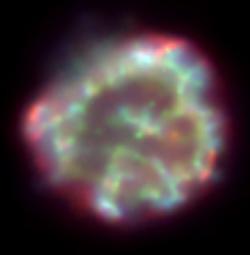Astronomers have a lot in common with medical examiners. We study events after they have happened, looking for clues that tell us what occurred, when, and why. While MEs can examine a body in their autopsy rooms, astronomers are generally stuck observing stellar corpses from afar.
Of course, an advantage we have over MEs is that, almost every time, our crime scenes (and the corpus) are beautiful to look at:

Photo by ESA/Hubble & NASA. Acknowledgement: Claude Cornen
That lovely and seemingly-delicate object is SNR 0519-69.0, seen here as observed by the Hubble Space Telescope. I say seemingly, because gentle it is not: It is the rapidly expanding remains of a star (SNR stands for Supernova Remnant) that exploded some 600 years ago. This supernova event was huge, releasing as much energy in a few days as the Sun will over its entire lifetime—in other words, it was many, many billions of times more luminous than the Sun.
Good for us it’s located over 160,000 light years away! It’s in another galaxy, in fact: the Large Magellanic Cloud, a dwarf companion galaxy to the Milky Way.
What you’re seeing is the debris from the event, already about 25 light years across, expanding at several thousand kilometers per second. That’s a speed dozens of times faster than the fastest speed ever achieved by a human-built space probe, and we’re talking about something like an octillion tons of matter blasting outward at that velocity. It crushes any achievements of humanity into microscopic dust.
Examining this ridiculously over-muscled event tells us a lot about it. For example, we know that supernovae can happen when a very massive young star explodes, or when a much smaller and far older star does so.

Photo by K. Borkowski et al.
When trying to figure out what happened to a body, an ME might X-ray it. Astronomers do that to, but instead of sending X-rays through it, we look at the X-rays coming from it. A supernova from a young massive star emits X-rays differently than a supernova from an older star, and in the case of 0519, it’s clear it was the latter, what we call a Type Ia event.
The key player is a star that is a bit more massive than the Sun, which is at the end of its already long life. It’s past the red giant stage, having used up all the fuel in its core and blown off its outer layers. All that’s left is the naked, exposed core of the star, an über-dense object called a white dwarf. If this bizarre dead star has a companion star, it can siphon off material and collect it on its surface. When enough of the material piles up, it undergoes catastrophic nuclear fusion, which can disrupt the structure of the entire star. The white dwarf explodes, briefly lighting up the Universe, capable of outshining an entire galaxy for a few days.
The companion star is of interest to astronomers; it can come in the form of a normal star like the Sun, an ancient star like a red giant, or even another white dwarf. Each provides a slightly different path to destruction, and so studying them helps astronomers understand what happened prior to the bang.
In this case, the Hubble image gives strong clues to the identity of that star. Looking carefully over the region in the center of the remnant, only about two dozen stars were found, and all of them were normal ones like the Sun, not evolved red giants. That rules out the latter as a possible companion. I’ll note that when two white dwarfs merge and explode, they are utterly destroyed, leaving nothing behind. So actually not seeing anything at the explosion site means it might have been that type of event. Sometimes what you don’t see is important, too.
The wispy material is another clue as to what’s going on; those are formed by shock waves as material from the expanding explosion slams into the ambient gas and dust that exists in space. X-ray and infrared observations also corroborate that idea. Shock waves are sonic booms, created when something hits something else faster than the speed of sound in the material. Since information travels through material at the speed of sound, a supersonic impact means the matter is literally “shocked”, surprised that something hit it. This compresses the material, heating it up, and in this case causing it to glow in IR and X-rays. The red filaments in SNR 0519-69.0 are hundred-trillion-kilometer-long tendrils of hydrogen, squeezed and heated as they slam into the tenuous stuff between the stars.
Come to think of it, there’s another similarity between astronomers and medical examiners: Over time, we both build up a body of knowledge that helps us solve future cases. In the case of astronomy, our past experience with exploding stars (some very similar to 0519 indeed) helps us understand each new one we find, but it’s more than that. Type Ia supernovae explode with a pretty well-defined total energy, which means that each one has a predictable maximum brightness. Since they can be seen at vast distances, we can use them as milestone markers, determining their distance even when they lie billions of light years away.
Supernovae are beacons that allow us to measure the universe itself. And the more we study them, the better we get at it.
Science! We’ve only been doing it for a few hundred years, but its methods allow us to look back billions. It’s not a crime we’re hoping to solve, but the very nature of existence itself. Over the centuries, we’ve built up quite the body of proof for it, too.